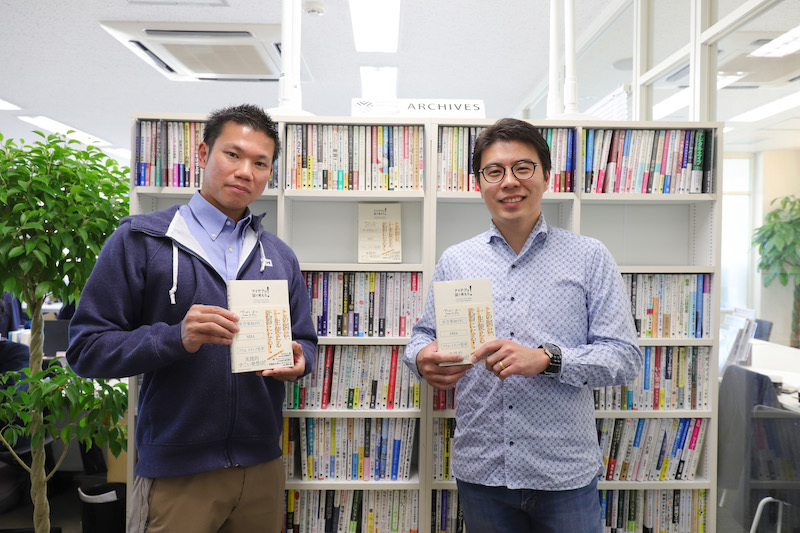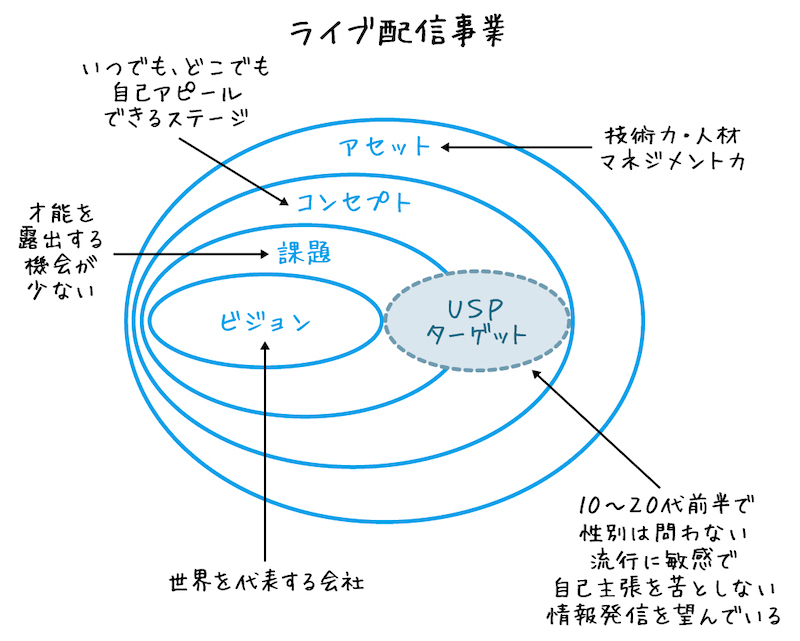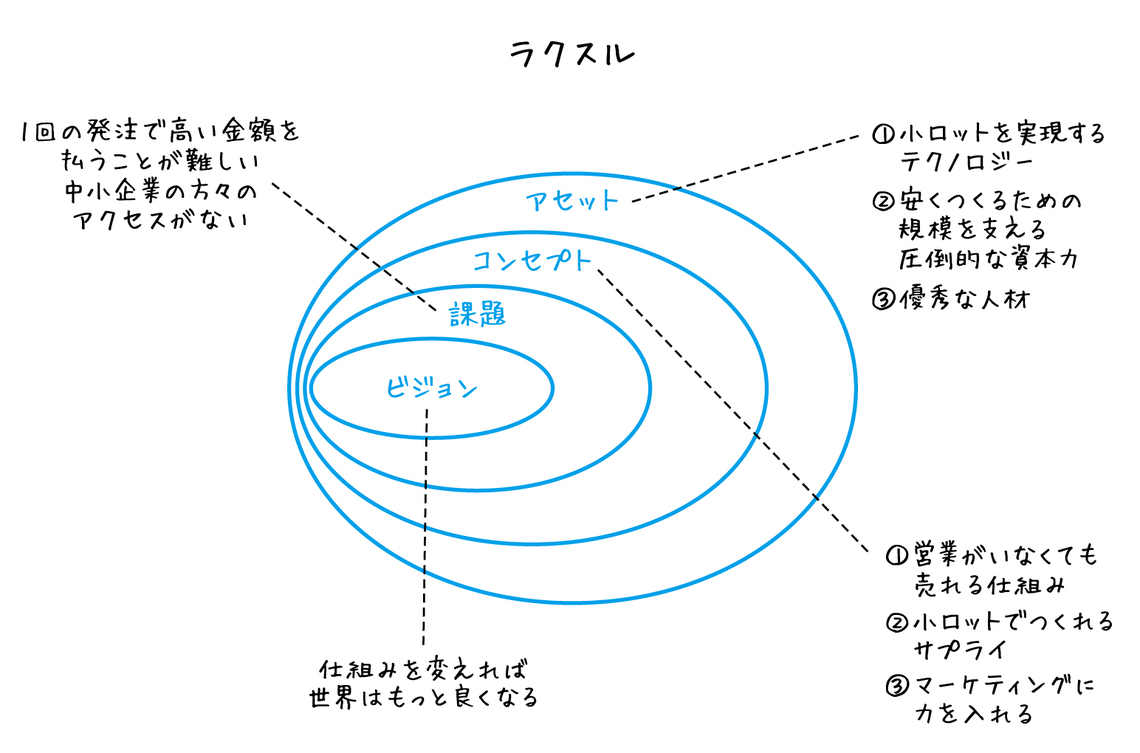This series explores the potential for idea generation through conversations with experts, starting from Dentsu Inc. Creative Planner Aaron Zoo's book " Think in Diagrams!," published in October 2021.
This time, Executive Officer Yudai Takashiro, who has spearheaded numerous business developments at Raksul, and Aaron Zu, a Dentsu Creative Planner, reflected on their respective careers and discussed the know-how and mindset required to create "0→1" within a company.

(From left) Rakusuru's Takagi, Dentsu Inc. Aaron
How They Met and Their Path to Business Development
Aaron: I first met Takagi-san when we were assigned to the same sales department at a major telecommunications company right after graduating.
Takagi: Even back then, we both operated pretty freely, didn't we? During new employee training, Aaron-san would say things like, "Is this training even meaningful?" I remember thinking, "This guy is trouble," while watching him. Apparently, behind the scenes, I was called the "Japanese version of Aaron," so I guess we both had a bit of an edge (laughs).
At the major telecom company, I was assigned to the Niigata branch and handled new business sales. My routine was to call 50 companies after arriving in the morning, then visit 10 of them. Within half a year, I became one of the top performers in sales within the branch. The Niigata branch had an environment where we handled engineering in-house too. It was a great experience to be able to do everything from sales to server setup, network design and construction, and app customization and implementation.
The turning point came while working in India, talking with the president and founders of the local subsidiary. Speaking with people who had graduated from Stanford, started companies, and built businesses worth tens of billions of yen within five years, I realized they weren't on the path my current job offered. I thought, "If I stay at this company, it'll take at least 15 years to reach a level where I can talk with them as equals. I can't wait that long." That was why I quit.
Aaron: My reason for leaving was similar to Takagi-san's. While I gained invaluable experience, the biggest factor was not seeing anyone within the company who fit the future I envisioned for myself.
Takagi: After that, when I was deciding what to do next after consulting, I faced a choice: start my own business or work within the "box" of a company.
When I considered the purpose of my work, I realized that seeing services or businesses I created endure in the world was what would bring me satisfaction in life. As someone who loves traveling and visiting World Heritage sites, I often feel that humans are creatures who want to leave something behind, like ruins or works of art. For me, that something I wanted to leave behind was a business.
To build a business that would endure, I concluded that operating within the "box" of a company offered far greater leverage of capital than relying solely on my own funds. It also allowed for faster business growth over time. That's why I chose to build a business while belonging to an organization.
Among various companies, I chose Raksul because it attracts assets like funding and talented people, and it has a clear vision. Crucially, that vision aligned perfectly with the kind of business I wanted to build.
Aaron: So at your third company, Takashiro-san, you adopted a high-level managerial perspective.
When I was in the U.S. Air Force training unit, my superiors constantly told me, "Digital is next." So, I approached my next company with the perspective of understanding the full scope of digital.
Digital fundamentally has infrastructure at its lowest layer, with systems above that, and applications on top. So, at my first major telecommunications company, I learned about infrastructure. For my second company, I chose a major IT firm to learn about the upper-layer systems.
There, I learned by doing how systems operate within the context of societal deregulation, such as electricity liberalization reforms. This experience fueled my desire to use IT systems to achieve greater freedom in various endeavors, leading me to join a mega-venture as my third company. At the mega-venture, while I had freedom to act, results were also demanded. It was there that I finally began tackling management-related tasks and creating things myself.
Takagi: In terms of gradually shifting toward a management perspective—setting strategies, concepts, and visions—our career paths so far have quite a few commonalities.
The "Growth Model: Stump Buzz Theory" for Generating Business Ideas
Aaron: After the mega-venture, I went to business school to gain a managerial perspective more quickly.
Before business school, I vaguely thought business was the main thing, and that if the business was good enough, people would follow. But it was completely different; I learned that people are everything.
If you have the right people, you can succeed even with a weird business. Conversely, if you have the wrong people, even the best business will fail. So people are incredibly important.
When trying to inspire these vital "people," I realized that a clear management vision is what truly matters. This line of thinking led to the conceptualized idea: "Growth-Oriented: Stump Buzz Theory."
First, the vision is at the center. The key point is how effectively you can permeate that vision throughout the organization. That's why lengthy company mottos often don't work well. What's important is a simple vision that every employee can immediately grasp and think, "Ah, I see."
When the vision is clear, each employee naturally starts thinking, "Where am I aiming to be right now?" and "What should I be doing right now?" This naturally builds employee motivation.
Next, assets are crucial. What strengths do your team members bring? For example, having a white hat hacker means engineering strength; having someone with PR experience means PR strength. These become assets. So, vision and assets must exist first.
However, the real key to business development is "discovering problems." Take the live streaming business as an example. You wouldn't decide to create a live streaming business just because you have a grand vision of "becoming a world-class company" and assets like engineering skills. Before that, you need to identify a societal problem you want to solve. For instance, the problem of aspiring entertainers lacking opportunities to showcase their talent or platforms for self-expression.
For an organization with strong engineering capabilities and a solid vision, the solution to this problem is to create a platform for self-expression using IT. This is how we ultimately arrive at the business idea of "live streaming."
Then, if you establish the concept "your own stage anytime, anywhere" for the live streaming business, the vision, assets, challenge, and concept are complete. Next, you consider which target audience to aim for and how to differentiate the live streaming business with what unique selling point (USP).
With this in mind, I developed the "Growth Model: Stump Buzz Theory" to serve as a compass for building any business.
Takagi: I think the "Growth-Oriented: Stump Buzz Theory" is incredibly sharp. Defining the asset as "people" is especially brilliant. Traditional management theories often define people, materials, and money as management resources, but Japanese society is changing.
The environment for raising capital is vastly improved compared to before. And it's people who create valuable things and spend money. In that sense, I really resonate with this theory because my own management style also prioritizes people above all else in business operations.
Raksul champions the vision that "Changing systems makes the world better." What we want to convey with this vision isn't "Let's change the printing industry," but rather "We are a company that changes systems."
Many people believe that changing systems will absolutely make the world better. I think our strength lies in presenting a vision that resonates with such people and gains their empathy.
How does Rakusuru fit into the "Growth Model"?
Takagi: Regarding the printing company I currently oversee, it was the very first business launched by Raksul under the vision "Changing systems makes the world a better place." When the company was founded, CEO Matsumoto set his sights on this "printing industry." It was an inefficient industry structure supported by multiple layers of subcontractors, making it precisely the kind of "system" that needed changing.
Printing was a highly specialized field where placing orders correctly was difficult without knowledge of software like Illustrator or the hardness of the paper being printed.
Consequently, the standard business model relied on sales representatives from printing companies gathering customer requests and taking orders. Considering the labor costs associated with sales, it was difficult to lower the price per order. This created a problem: small and medium-sized enterprises (SMEs), who often struggle to pay high amounts per order, couldn't fully access printing services.
We addressed this by leveraging the internet to create an environment where SMEs could access printing services. We defined three core concepts: ① A system that sells without salespeople, ② A supply chain enabling small-lot production, and finally, ③ Focusing on marketing to aggregate small-lot orders and achieve economies of scale.
To execute this, we assembled the necessary assets: technology to smoothly handle small-lot orders received online and manage production; overwhelming capital to achieve economies of scale; and, crucially, a management team composed of members from BCG, Carlyle, and internet companies. Under their leadership, we built an organization by gathering top talent.
Applying the "Growth Model: Stump Buzz Theory" to Raksul, I believe it would look like this.
Aaron: Impressive how you've organized this. In terms of "disrupting existing systems," what Rakusuru did isn't just creating opportunities for small businesses—it's innovation.
They split the market into two segments: printing systems for large corporations and printing systems for small and medium-sized enterprises. Since large corporations make up only about 1% of all Japanese companies, this innovation effectively covers 99% of the Japanese market. That's remarkable.
Takagi: People often say "printing is a declining industry." But our assessment is that it's actually a growth industry. From the peak of corporate cost-cutting after the 2008 Lehman Shock until 2020, commercial printing orders didn't decline. Considering Japan's population pyramid and wealth distribution, the vast majority of people still access information through paper media. So companies can't completely abandon paper and go fully digital.
When developing a business concept, market selection is crucial. It's not just about simplistically thinking, "Print is old-fashioned, it's shrinking." We need to sharpen our focus and truly assess whether the market is genuinely attractive.
Aaron: Exactly. Some might wonder why a printing company can grow so much. But what Raksul is doing is essentially "ambidextrous management."
They're simultaneously deepening their existing business through "knowledge deepening" while also exploring new ventures through "knowledge exploration."
This approach led to the creation of new logistics systems like "Hakoberu." Companies in decline often seem fixated solely on "knowledge deepening." They pour all their energy into existing businesses and completely neglect "knowledge exploration."
In Rakusuru's case, even if print media were to weaken someday, they are building other businesses now to ensure they can be supported. Japanese companies should spend more time pursuing "knowledge exploration" over the medium to long term. It's impossible to think, "We have to fix this within three years" once existing businesses start declining. Some companies may fall into the "success trap," relying too much on past successes in existing businesses, and thus fail to achieve ambidextrous management.
Takagi: We too have been having similar conversations at the management level for the past two to three years, aiming to realize this ambidextrous management.
Japan is a country where new ventures are relatively easy to launch
Takagi: Japan has fewer potential entrepreneurial competitors, making it a country where launching new ventures is remarkably easy in that sense. If you have an idea you can execute, just stepping up to the plate and swinging the bat is a very good approach for the domestic Japanese market.
Aaron: Regarding new ventures, Japan still has a vast blue ocean. For example, in San Francisco or Los Angeles, starting a business and challenging new things is already deeply ingrained as a cultural norm.
Of course, not everyone working at large corporations can engage in new business development in the same way. Even so, when it comes to creating something new, the Japanese market feels far too stagnant. I believe there's still significant potential for growth, so I really want young people to take on the challenge.
Takagi: I also recommend the approach of leveraging the "box" that is a company. Isn't it an incredibly good environment where you can swing the bat without taking on the risk of personal debt? Of course, there will be tough and painful times too...
Since such talent is scarce in Japan, successful experiences carry real value. Even small-scale ventures are fine. Applying ideas to a framework and testing them is great training. You'll notice many mistakes through practice.
Aaron: About 70% of new businesses absolutely pivot. So overthinking and overplanning are counterproductive. What's more important is the adaptability and flexibility to pivot when needed. Excessive risk avoidance is nothing but a hindrance for new ventures.
Takagi: I've launched various businesses at Raksul, and two of them have been shut down, so my success rate is about 50%. Company-wide, we aim for about a 30% success rate, operating on the premise that 70% will fail. Approaching things with that mindset creates psychological safety, which I think is beneficial.












